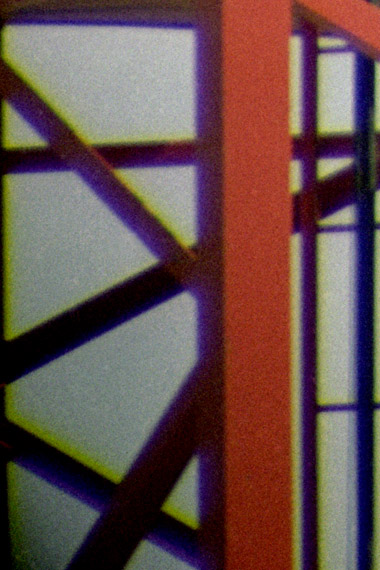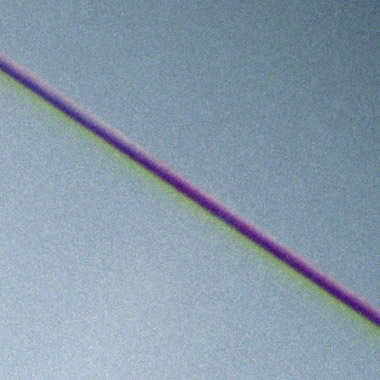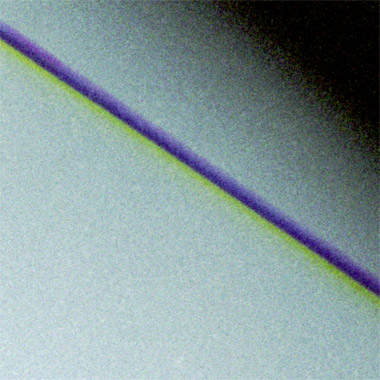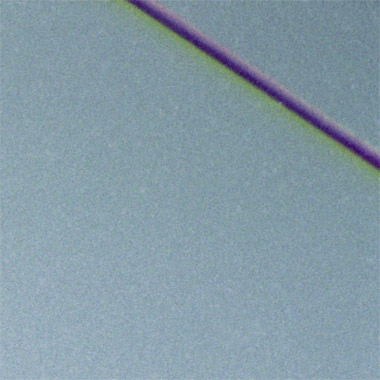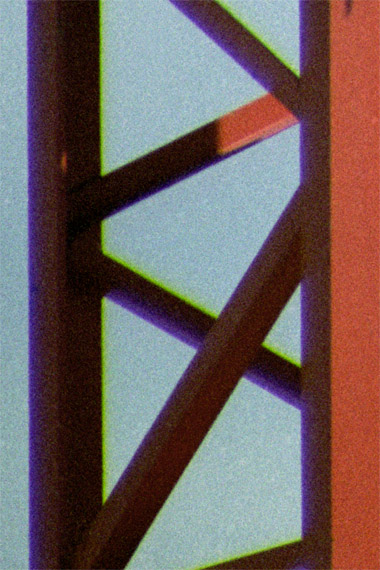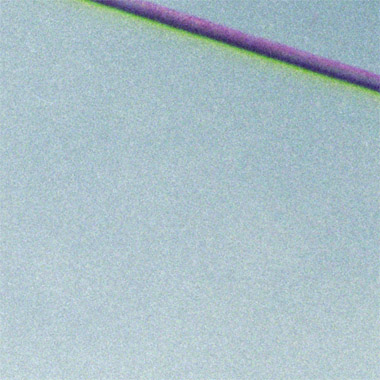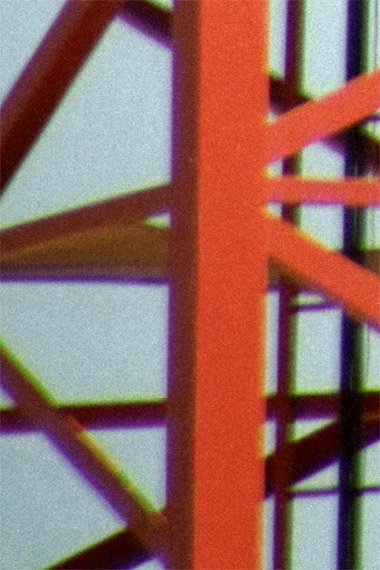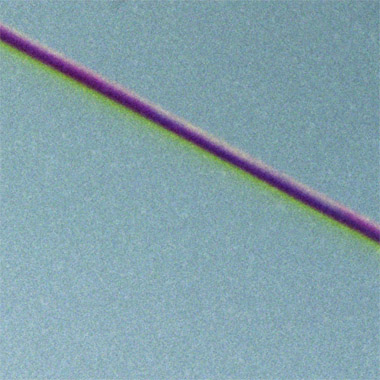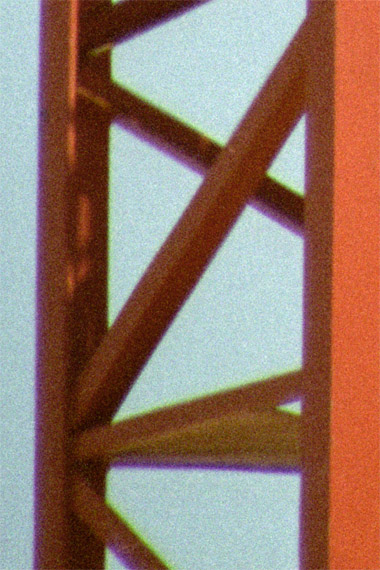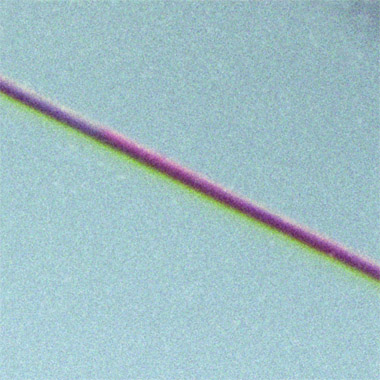Medium Format Lenses with
the Pentacon Six Mount
A comparative test
by TRA
Further 1000mm lens tests
Part 3
The Test Results, continued:
The two standard 500mm lenses
with a 2× converter
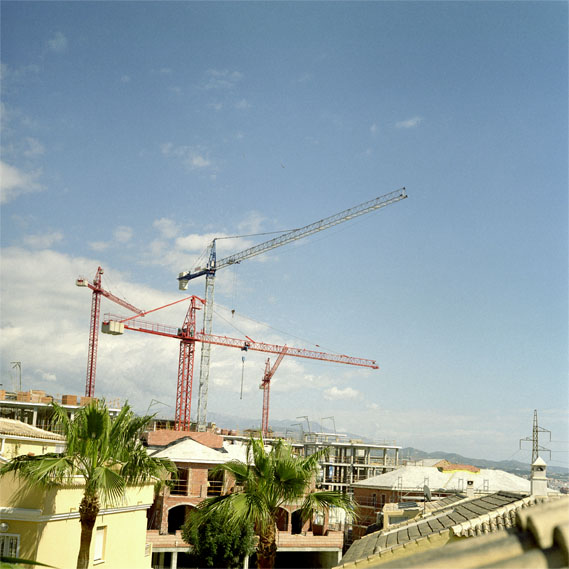
[C427-7] View chosen for the 500mm 1000mm tests
A reminder of the coverage given with the 80mm standard lens.
Compare it with the area covered below at 1000-1200mm!
1980s Biometar f/2.8 80mm at f/9.5 1/500
Fuji NPC 160
Arsenal Arsat 500mm APO lens
with Arsenal 2× converter
Coverage
The results with this combination are quite frankly extremely disappointing.
There is considerable vignetting at maximum aperture, especially in the
top corners and along the whole of the bottom edge. I wonder if this
is caused by obstruction from the raised mirror, only occurring when the
light rays are nearer to parallel, i.e., with lenses of extremely long
focal length. When the lens is set at f/11, the vignetting does not
extend so far into the picture, but it is still extremely obvious.
Along the bottom edge it has virtually disappeared, but the transition
to vignetting in all four corners is a lot sharper.
Arsat 500mm APO lens with Arsenal 2× converter
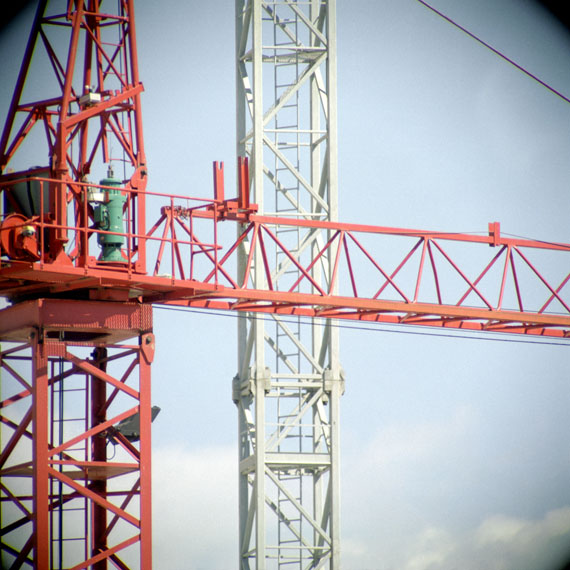
[C426-17]
Arsat 500mm f/5.6 APO lens with Arsenal 2× converter
at f/5.6 (effective f/11) 1/125
|
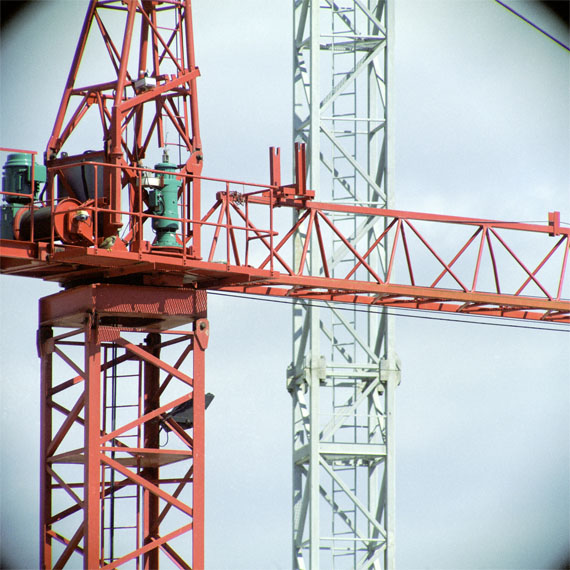
[C427-11/12]
Arsat 500mm f/5.6 APO lens with Arsenal 2× converter
at f/11 (effective f/22) 1/250 (after a change in the light)
|
Fuji NPC160
The f/11 (effective f/22) shot was also taken [C427-1/2] with a different
shutter speed (1/60) after a change in the light, with identical results
as regards coverage.
Resolution
Even at full aperture the resolution in the centre is very good, although
as one gets nearer the edges and especially the corners, colour fringeing
and then vignetting detract from the apparent sharpness of the image.
At maximum aperture, depth of field is of course very shallow, and it is
impossible to get both cranes in focus. Stopping down to f/11 naturally
results in a considerable increase in depth of field, bringing both cranes
into reasonably sharp focus. At the extreme degrees of enlargement
that I am using to check these images, it is possible to see that the image
does sharpen up considerably at the smaller aperture, but this may in part
be because focus was not spot-on.
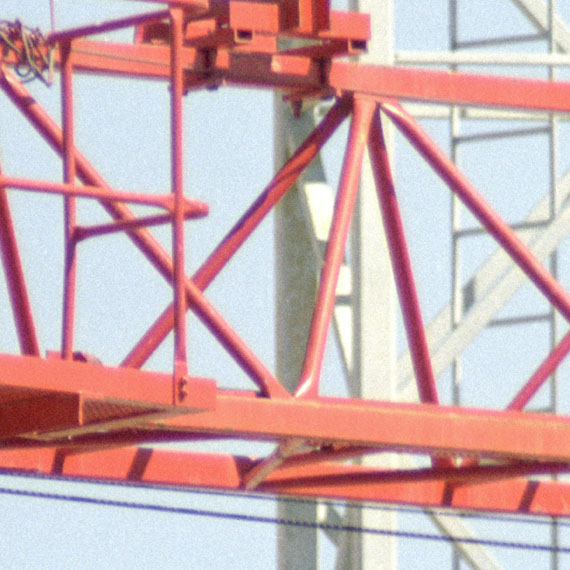
[C426-17r]
Arsat 500mm f/5.6 APO lens with Arsenal 2× converter
at f/5.6 (effective f/11) 1/125
|
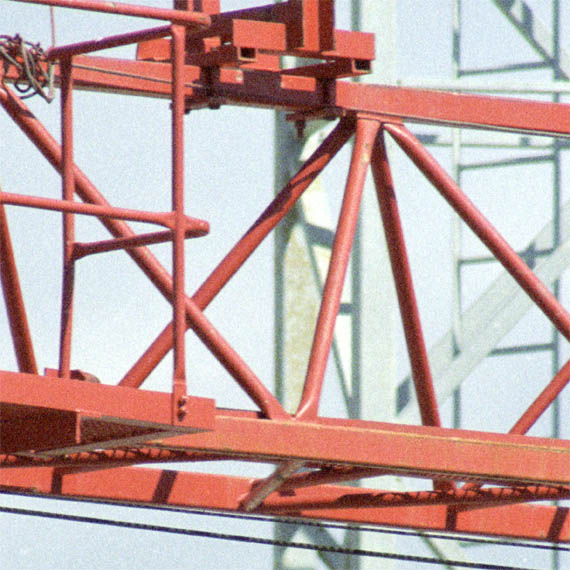
[C427-11/12r]
Arsat 500mm f/5.6 APO lens with Arsenal 2× converter
at f/11 (effective f/22) 1/250 (after a change in the light)
|
Fuji NPC160
Colour Fringeing
This combination provides chromatic aberrations to write home about!
In the centre it is not visible, but towards the edges it is apparent when
the image is greatly magnified, and towards the corners it is massive.
Stopping down to f/11 does not result in a significant reduction in chromatic
aberration. In fact, as the image sharpens up, perhaps the chromatic
aberrations are more obvious at this degree of enlargement. With
the 2× converter being used, this is of course equivalent to f/22,
and it is doubtful if users are going to be able to stop down more than
this without having to use shutter speeds that would be so slow that image
sharpness could be degraded by subject or camera movement.
Fuji NPC160
The key question about the vignetting and colour fringeing is this:
is this problem inherent in the APO lens on its own, in the converter on
its own, or a consequence of using the two together?
Arsenal Arsat 500mm APO lens
with Schneider-Kreuznach 2× converter
The 2× converter used here is of course the one designed for use
with the longer Schneider lenses on the Exakta 66.
The rear element of the APO lens and the diaphragm behind it! are
well recessed within the lens, so mounting the Schneider converter with
its protruding front component is no problem at all.
Coverage
These are the shots that show that the vignetting problem is caused
by the Arsenal 2× converter, not by the APO lens itself . Using
the Schneider converter, the very bad vignetting seen with the combination
of the APO 500mm lens and the Arsenal 2× converter disappears.
At maximum aperture, performance is very close to that obtained by this
lens on its own see the 500mm-600mm review here.
There is some slight fall-off in brightness just visible in the upper corners
in these shots of a clear blue sky, but most people would not notice it,
and it is in fact less than when the lens is used on its own. With
the lens stopped down to f/11, this hint of darkening disappears almost
completely, leaving a tiny mark in the top-left corner of the negative,
within the area that was masked in the processing lab and therefore not
on the print. Remember that I am printing and examining beyond
the limits of the frame that is usually printed or visible within a
slide frame. Even at full aperture, coverage is actually better than
with the Carl Zeiss Jena 1000mm Spiegelobjektiv, which itself is
quite satisfactory.
Arsenal 500mm APO lens with Schneider-Kreuznach 2× converter
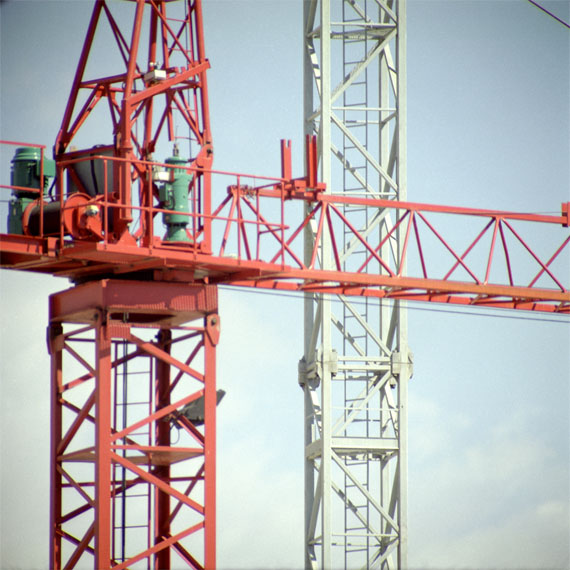
[C427-3]
Arsat 500mm f/5.6 APO lens with Schneider 2× converter
at f/5.6 (effective f/11) 1/125
|
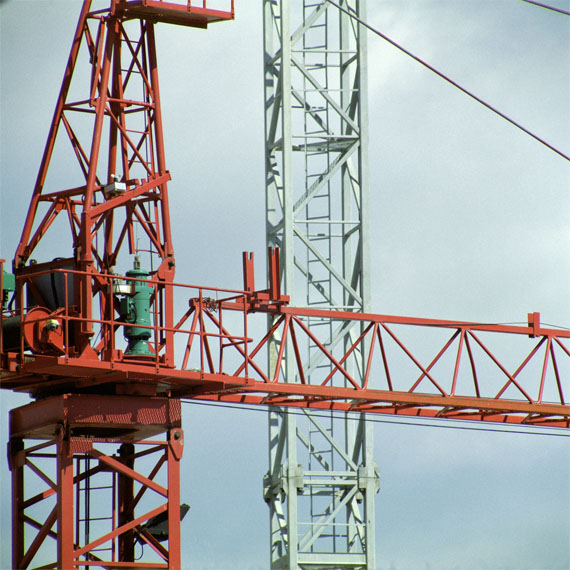
[C427-10]
Arsat 500mm f/5.6 APO lens with Schneider 2× converter
at f/11 (effective f/22) 1/250 (after a change in the light)
(under-exposed one stop)
|
Fuji NPC160
The f/11 (effective f/22) shot was repeated [C427-4] with a different
shutter speed (1/60) after a change in the light, with identical results
as regards coverage.
Resolution
At maximum aperture, resolution is excellent. Inevitably, when
the lens is stopped down to f/11 (effective f/22 as regards light transmission,
through the 2× converter), the depth of field increases substantially
and the image sharpens up throughout. This may in fact reveal that
focus was a fraction off, and at full aperture this would be visible at
the great degree of magnification used in these tests.
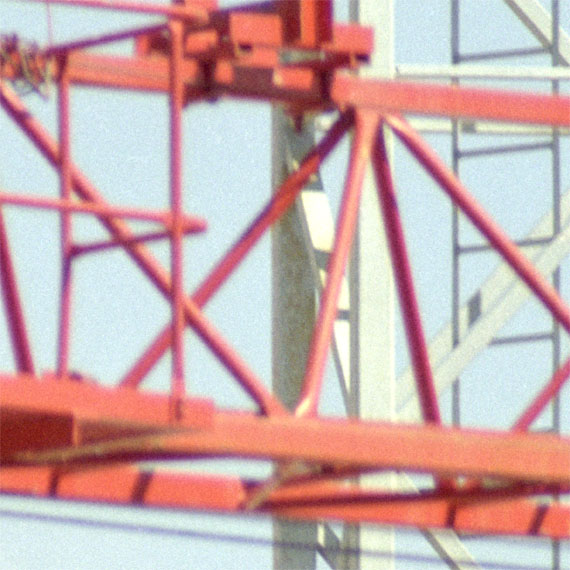
[C427-3r]
Arsat 500mm f/5.6 APO lens with Schneider 2× converter
at f/5.6 (effective f/11) 1/125
In this shot, critical focus is clearly on the rear crane.
|
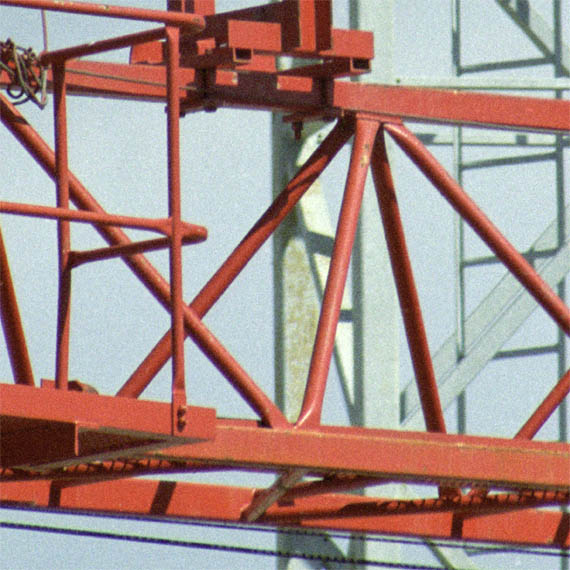
[C427-10r]
Arsat 500mm f/5.6 APO lens with Schneider 2× converter
at f/11 (effective f/22) 1/250 (after a change in the light)
(under-exposed one stop)
Note the increase in depth of field at this aperture.
|
Fuji NPC160
Colour Fringeing
Here we see the answer to the question that we asked above, when looking
at the results of using this lens with the Arsenal 2× converter:
The key question is this: is this problem inherent in the APO lens on
its own, in the converter on its own, or a consequence of using the two
together?
It is now clear that the massive colour fringeing observable when the
image taken with this lens plus the Arsenal converter is greatly enlarged
is in large part due to the presence of the Arsenal converter.
There is still some colour fringeing when the APO lens is used with
the Schneider 2× converter, but it is approximately the same as the
chromatic aberration observable when the lens was used on its own. This
seems to indicate that no chromatic aberrations are introduced by
the Schneider 2× converter, but considerable chromatic aberrations
are introduced by the Arsenal 2× converter.
Fuji NPC160
When the lens is stopped down the same degree of chromatic aberration
is present as at full aperture although this is not visible at normal
degrees of enlargement. In fact, the increased sharpness of the edges
of structures within the image may even make the colour fringeing more
visible, but only at massive degrees of enlargement.
Pentacon f/5.6 500mm with
Schneider-Kreuznach 2× converter
Given the disappointing results when the Arsenal 2× converter
was used with their 500mm APO lens, on this occasion I decided to test
the Pentacon only with the Schneider converter.
Coverage
On the print from the lab, coverage looks virtually
faultless perhaps a slight decrease in brightness towards the
corners, only visible in this shot because of the totally clear, blue sky.
On the negative, it is possible to observe a tiny amount of additional
darkening in the top, left-hand corner, and along the bottom edge of the
image, although this is probably within the area that would be masked in
an enlarger or a slide mount, as indeed it was in the print from
the lab. There is scarcely any difference between full aperture and
stopping down to f/11 as regards coverage. The darkening at the extreme
top-left corner becomes more pronounced when stopping down, as the brightness
of the rest of the image evens up, but this is not visible on the print
from the lab, and so we can assume that it is in fact outside the normal
image area. Since images taken with all long lenses show this corner
darkening, it appears to me that this is probably a shadow from something
within the camera throat itself, and so not caused by the lens. However,
since it is not within the image area, it is not of significance.
It is not to be confused with the deep vignetting introduced when the Arsenal
2× converter is ued, which intrudes very visibly into the image area.
Pentacon f/5.6 500mm with Schneider-Kreuznach 2× converter
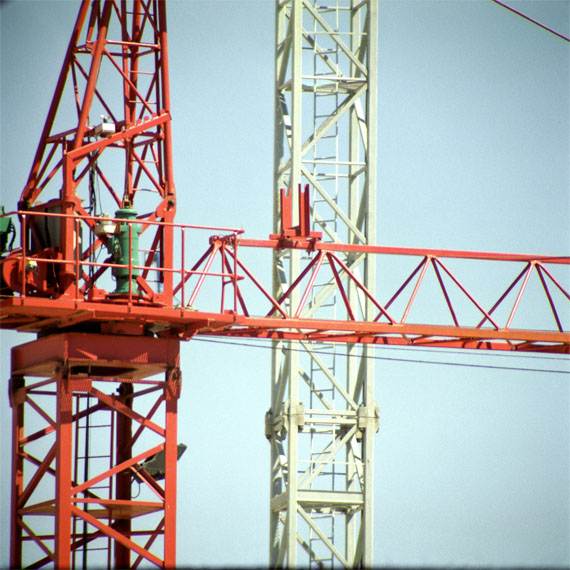
[C430-1]
Pentacon 500mm f/5.6 with Schneider 2× converter
at f/5.6 (effective f/11) 1/250
|
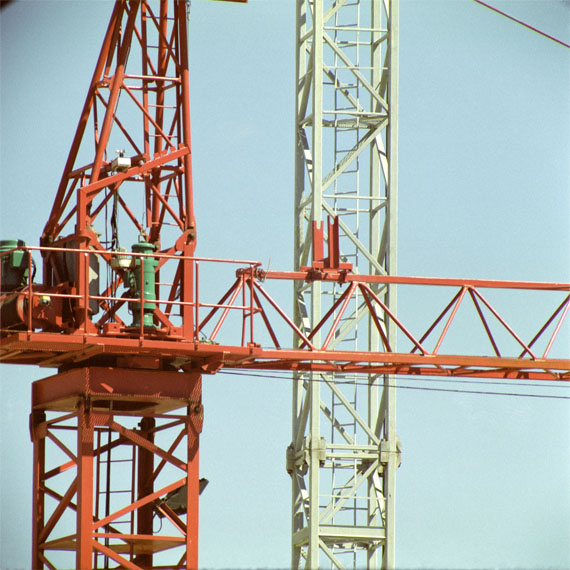
[C430-2/3]
Pentacon 500mm f/5.6 with Schneider 2× converter
at f/11 (effective f/22) 1/125 (under-exposed one stop)
|
Fuji NPC160
Resolution
Resolution at full aperture is excellent. Stopping down to f/11
inevitably increases the depth of field, which with such a long lens and
converter combination naturally sharpens up parts of the image. However,
for all normal purposes, the full-aperture resolution is very acceptable.
This is another excellent result.
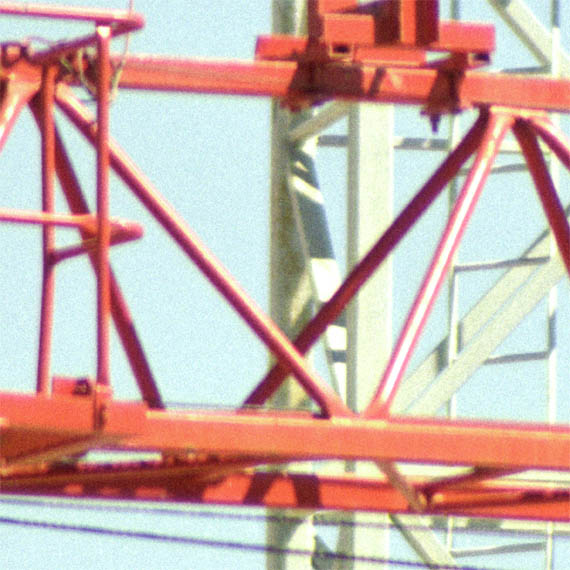
[C430-1r]
Pentacon 500mm f/5.6 with Schneider 2× converter
at f/5.6 (effective f/11) 1/250
Sharpest focus is slightly behind the red crane.
|
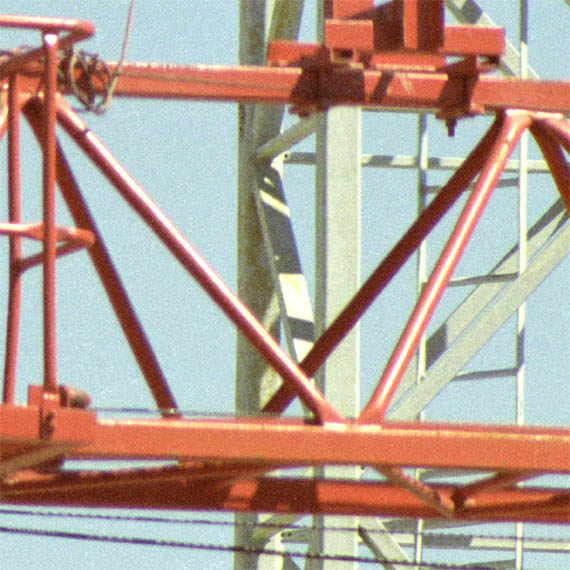
[C430-2/3r]
Pentacon 500mm f/5.6 with Schneider 2× converter
at f/11 (effective f/22) 1/125 (under-exposed one stop)
|
Fuji NPC160
Colour Fringeing
There is a very small amount of colour fringeing, only visible
at massive degrees of enlargement, when the 500mm Pentacon lens is used
with the Schneider-Kreuznach 2× converter. The results with
the 1000mm Carl Zeiss mirror lens are better but then, mirror lenses
do not suffer from chromatic aberrations. At full aperture and using
the Schneider 2× converter with each lens, it is hard to say which
lens is better, the Arsenal APO 500mm or the Pentacon 500mm. Stopping
down the lens does not normally change the amount of chromatic aberration,
but with this lens stopped down to f/11 (effective aperture through the
converter, f/22), colour fringeing does in fact appear to be less obvious.
At either aperture it is in any case too small to be observable at any
normal degree of enlargement. Note that in these enlargements we
can see the grain of this ultra-fine-grain film!
Fuji NPC160
To go on to the next section, click below.
Further tests of 1000mm & 1200mm lenses,
Part 4
To go back to the beginning of the lens tests, click below and then
choose the focal length that you want to read about.
Back to beginning of lens tests
Home
© TRA November 2007, November 2008





